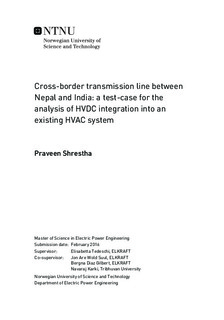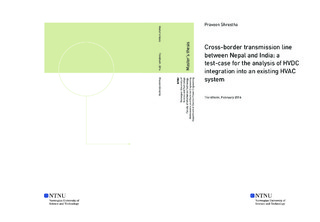| dc.description.abstract | Nepal has huge hydropower potential of 83,000 MW, of which 42,000 MW is technically and economically feasible. According to the annual report of Nepal Electricity Authority, the total installed capacity of hydropower in Nepal is only 733.57 MW. Although bestowed with tremendous hydropower resources, only about 40% of Nepal s population has access to electricity and remaining 60% faces severe load shedding. In this scenario, the cross border transmission links between Nepal and India serves two purposes. First, since Nepal still is short of electric power, these transmission links can be used to import power from India. Second, in future when there is surplus electric power in Nepal, it can be used to transfer power to India.
In the thesis, a model of integrated power system of Nepal is made in the Matlab Simulink. All the major power plants with capacity above 30 MW has been considered. The plants are connected to major loads with the transmission lines. In the start of the thesis, it was planned to find the real parameters of generators, governors, excitation systems, power transformers, transmission lines and loads. But later because of difficulty in finding the real parameters, the standard values were used. The grid on the Indian side is represented by three phase voltage source.
The best place for transmission link with India is in the central region between Butwal and Dhalkebar. Among different options for putting cross border transmission line, Dhalkebar-Muzaffarpur link is considered for the thesis. Different possible configuration were made using HVAC and HVDC in the cross border link. The HVAC link is considered first and then HVDC is kept in parallel. The power through the HVDC transmission line is regulated by setting the parameter values in the controller of the HVDC model. The simulation result shows that the system is unstable when there is HVAC in the cross border link. With HVDC only, the system is stable and also the control of the power flow through cross border is possible. Different condition of power transfer has been obtained and presented.
Even though the values of generators parameters were taken as standard parameters, the excitation and governor parameters were same for all power plants. Either real value of the parameters should be used or standard values should be used according to the size and location of the power plant. The location of hydropower plants and load center are exact. The rated capacity of Upper Tamakoshi hydro plant is taken as 100 MVA, although its actual capacity is 540 MVA. It was because for its rated capacity above 100 MVA, the system becomes unstable. During the simulation, the control of power flow through HVAC was not possible. The model involving HVAC was not stable also. Stable condition were found using HVDC only. | |

